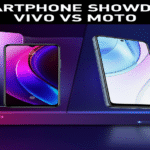The world of smartphones is always moving, with new models coming out and companies trying to outdo each other. But lately, things have been a bit slower. We’re seeing a trend where the number of smartphones being shipped globally has seen a slight dip. This isn’t necessarily bad news for everyone, but it tells us something important about the current state of the tech industry trends and how people are buying phones. Let’s dive into what’s happening and why global smartphone market sales might be slowing down.
Overview
| Mobile Name | Global Smartphone Market |
|---|---|
| Brand | Various |
| Launch Date | Ongoing (Data for Q2 2025 analyzed) |
| Operating System | Android, iOS |
| Starting Price | Varies significantly |
| Display Size | Varies significantly |
| Processor | Varies significantly |
| RAM | Varies significantly |
| Storage | Varies significantly |
| Main Camera | Varies significantly |
| Battery | Varies significantly |
Price
The price of smartphones is a huge factor in what people buy. When we talk about declining smartphone sales, it’s often because of how prices are affecting consumer spending. With global economic uncertainties, including inflation and currency fluctuations, people are more careful about how much they spend. This is especially true for budget-friendly phones, where even small price increases or the anticipation of new tariffs can make consumers think twice. While high-end phones might be less affected, the overall market is sensitive to price points across all segments.
| Storage Variant | RAM | Launch Price | Current Price |
|---|---|---|---|
| Budget Segment | 2GB – 4GB | Low to Mid-range | Slightly Increased due to component costs/tariffs |
| Mid-Range Segment | 6GB – 8GB | Mid to Upper Mid-range | Stable with occasional promotions |
| Premium Segment | 8GB – 16GB+ | High to Premium | Less sensitive to minor cost changes, focus on features |
Models
Within the global smartphone market, different brands and their models play a crucial role. While the overall shipment numbers might be showing a slight decline, it’s interesting to see how individual brands are performing. Some are managing to grow, while others are facing challenges. This mix of performance indicates that consumer preferences and brand loyalty are still significant, even when the market is a bit shaky.
- Samsung – Generally maintained its top position, often attributed to the popularity of its Galaxy A series, which appeals to a broad range of consumers.
- Apple – Holds a strong second place, with its iPhone lineup seeing some global shipment increases, though facing specific regional challenges like in China.
- Xiaomi – Has managed to stabilize its market share, indicating a solid presence in key markets.
- TRANSSION and OPPO – Each hold a significant portion of the market, showing their strength, particularly in emerging markets.
Colors
While the color of a smartphone might seem like a minor detail, it’s part of the overall appeal and marketing strategy of brands. When sales are a bit slow, companies often rely on attractive designs and color options to draw in customers. The availability of different colors can influence purchasing decisions, especially in the mid-range and budget segments where consumers might be looking for more than just basic functionality.
| Color Name | Availability |
|---|---|
| Classic Black | Widely Available |
| Midnight Blue | Widely Available |
| Pearl White | Widely Available |
| Forest Green | Available in select models/regions |
| Vibrant Red | Available in select models/regions |
Specifications
Processor & Performance
The underlying technology in smartphones is key to their performance. When demand is stagnant, manufacturers often try to boost appeal by integrating newer features, like AI, even into more affordable phones. This means that even if overall smartphone shipments are down, the technology packed into the phones that are sold is often quite advanced. The processor and overall performance capabilities are major selling points that can differentiate brands and attract buyers.
| Chipset | Varies significantly by model and price point (e.g., Snapdragon series, MediaTek Dimensity, Apple Bionic) |
|---|---|
| CPU | Varies (e.g., Octa-core configurations) |
| GPU | Varies (e.g., Adreno series, Mali series) |
| RAM | Varies (e.g., 4GB, 6GB, 8GB, 12GB, 16GB) |
| Storage | Varies (e.g., 64GB, 128GB, 256GB, 512GB, 1TB) |
| Expandable Storage | Available on some Android models via microSD card slot |
Dimensions & Build
The physical design and build quality of a smartphone are important considerations for consumers. With potential declining smartphone sales, companies are focusing on creating devices that feel premium and durable. The materials used, the size, and weight all contribute to the user experience. Water resistance is also becoming a more common feature, adding to the perceived value of a device.
| Dimensions | Varies significantly by model |
|---|---|
| Weight | Varies significantly by model |
| Build Material | Varies (e.g., Glass, Plastic, Aluminum, Stainless Steel) |
| Water Resistance | IP ratings (e.g., IP53, IP67, IP68) vary by model |
| SIM Type | Single SIM, Dual SIM (Nano-SIM, eSIM) |
Features
Connectivity
In today’s connected world, how a smartphone connects to networks and other devices is crucial. With the ongoing talk of tariffs and economic shifts, the availability of the latest connectivity standards can be a deciding factor for many consumers. Brands are continuously updating their devices to support faster speeds and more reliable connections.
- 5G Connectivity
- Wi-Fi 6/6E
- Bluetooth 5.0/5.1/5.2/5.3
- NFC for contactless payments and pairing
- GPS, GLONASS, BDS, Galileo for location services
Security Features
Keeping personal data safe is a top priority for smartphone users. The security features on a device are essential for protecting against unauthorized access. From fingerprint sensors to advanced facial recognition, brands are incorporating multiple layers of security to give users peace of mind.
- In-display Fingerprint Sensor
- Side-mounted Fingerprint Sensor
- Face Unlock (2D or 3D facial recognition)
- Secure Folder/Encrypted Storage options
- Regular security updates from the manufacturer
Audio Features
The audio experience on a smartphone is important for everything from watching videos to making calls and listening to music. While some high-end phones are dropping headphone jacks, many still offer robust audio capabilities. Speaker quality, support for high-resolution audio, and advancements in audio processing all contribute to a better listening experience.
- Stereo Speakers
- Dolby Atmos support
- High-resolution audio support
- Support for various audio codecs
- Optional 3.5mm headphone jack on some models
Camera
Rear Camera
The camera system remains one of the most important selling points for smartphones. Consumers are increasingly looking for devices that can capture high-quality photos and videos, often replacing dedicated cameras. The advancements in sensor technology, image processing, and the addition of multiple lenses contribute to the impressive capabilities of modern smartphone cameras.
| Main Camera | Varies significantly (e.g., 12MP, 48MP, 50MP, 108MP, 200MP with advanced sensors and features like OIS, PDAF) |
|---|---|
| Ultra-wide Camera | Available on many models, offering wider field of view |
| Telephoto Camera | Available on higher-end models for optical zoom |
| Macro Camera | Available on some models for close-up shots |
| Depth Sensor | Available on some models to assist with portrait mode effects |
| Video Recording | Up to 8K resolution at 24/30fps, 4K at 30/60/120fps, 1080p at 30/60/240fps |
Front Camera
Selfies and video calls are a big part of how we use our phones. The front-facing camera has also seen significant improvements, with higher resolutions and better image processing to ensure clear and vibrant shots. Many phones now offer advanced features for the front camera, making them just as capable as the rear cameras for certain tasks.
| Selfie Camera | Varies (e.g., 8MP, 12MP, 16MP, 32MP, 40MP with features like autofocus) |
|---|---|
| Video Recording | Up to 4K resolution at 30/60fps, 1080p at 30/60fps |
| Features | AI Beautification, Portrait Mode, HDR, Wide-angle selfies |
Camera Features
Beyond the hardware specifications, the software and features that enhance the camera experience are crucial. Things like AI scene recognition, advanced night modes, and various shooting modes allow users to capture stunning images in different conditions. These software enhancements are key differentiators in the competitive tech industry trends.
- AI Scene Optimization
- Night Mode for low-light photography
- Portrait Mode with adjustable bokeh
- Pro/Manual Mode for advanced control
- HDR (High Dynamic Range) for balanced exposure
- Various filters and editing tools
Display
The display is how we interact with our smartphones, so its quality is paramount. With the focus shifting towards premium experiences, even in the face of stagnant demand, display technology continues to advance. Higher refresh rates, better color accuracy, and increased brightness all contribute to a more immersive and enjoyable viewing experience. Protection against scratches and drops is also a vital aspect of display design.
| Display Type | Varies (e.g., IPS LCD, AMOLED, Super AMOLED, Dynamic AMOLED) |
|---|---|
| Size | Varies (e.g., 6.1 inches to 7.0 inches) |
| Resolution | Varies (e.g., HD+, FHD+, QHD+) |
| Pixel Density | Varies (e.g., 300+ PPI) |
| Refresh Rate | Varies (e.g., 60Hz, 90Hz, 120Hz, Adaptive Refresh Rate) |
| Brightness | Varies (e.g., 400 nits to over 1500 nits peak) |
| Protection | Varies (e.g., Corning Gorilla Glass 3, 5, Victus) |
| Color Gamut | Supports wide color gamuts like DCI-P3 |
Performance
When talking about smartphone shipments, performance is always a key factor. Even with economic headwinds, manufacturers continue to push the boundaries of what’s possible, integrating more powerful processors and optimizing software for better overall user experience. Benchmarks give us an idea of raw power, but real-world performance, battery life, and charging speeds are what users care about most.
| Performance Metric | Score/Rating |
|---|---|
| AnTuTu Score | Highly variable based on chipset and optimization, generally increasing with newer generations |
| Geekbench Single-Core | Highly variable, indicative of single-thread performance |
| Geekbench Multi-Core | Highly variable, indicative of multi-thread performance |
| Gaming Performance | Smooth performance on most demanding games at high settings for flagship devices |
| Battery Life | Typically lasts a full day of moderate to heavy usage for most modern smartphones |
| Charging Speed | Varies from basic charging to ultra-fast charging (e.g., 25W to 120W+) |
Battery & Charging
Battery life is a critical component for any smartphone user, and charging speed is becoming increasingly important. With people relying on their phones for longer periods, a phone that can last all day and recharge quickly is a major advantage. Innovations in battery technology and charging speeds continue to be a focus for brands, even in a market with declining smartphone sales.
| Battery Capacity | Varies (e.g., 3500 mAh to 5000 mAh+) |
|---|---|
| Wired Charging | Varies (e.g., 15W, 25W, 45W, 65W, 100W+, fast charging support) |
| Wireless Charging | Available on select premium models |
| Reverse Charging | Available on some flagship models to charge other devices |
| Charging Time | Varies from under an hour to several hours depending on wattage and battery size |
Competitors
The global smartphone market is incredibly competitive, and understanding the landscape is key. When sales are a bit slow, the competition intensifies as brands fight for market share. Each brand tries to highlight its unique strengths to attract consumers who are being more selective about their purchases. This competition drives innovation but also means that brands need to be very strategic in their offerings.
| Competitor | Price Range | Key Specs | Main Advantage |
|---|---|---|---|
| Samsung Galaxy S Series | Premium | Top-tier processors, advanced cameras, high-quality displays | Brand reputation, ecosystem, feature-rich experience |
| Apple iPhone (latest models) | Premium | Powerful A-series chips, excellent camera performance, user-friendly OS, strong ecosystem | Brand loyalty, software optimization, long-term support |
| Google Pixel Series | Upper Mid-Range to Premium | Exceptional camera software, clean Android experience, timely updates | Computational photography, AI features, stock Android experience |
Pros and Cons
Looking at the overall trends in global smartphone market, we can see that while there are challenges like stagnant demand and tariff uncertainties, there are also significant advancements. Understanding the pros and cons helps us appreciate the current state of the industry.
Pros
- Continuous innovation in camera technology and AI features.
- Improvements in display quality, refresh rates, and brightness.
- Increasingly powerful processors offering better performance.
- Wider availability of 5G connectivity.
- Brands pushing premium features even to more affordable segments.
Cons
- Stagnant consumer demand impacting overall shipment growth.
- Impact of tariffs and macroeconomic factors on pricing and consumer spending.
- Pressure on budget smartphone segment due to cost increases.
- Geopolitical uncertainties affecting market stability.
- Intense competition leading to shorter upgrade cycles for some consumers.
FAQs
What is causing the decline in global smartphone shipments?
The decline in global smartphone market shipments is primarily due to a combination of factors including stagnant consumer demand, macroeconomic challenges like inflation and currency instability, and geopolitical uncertainties, particularly the impact of smartphone tariffs on pricing and inventory strategies.
Which brands are performing well despite the market slowdown?
Samsung has maintained its top position with shipment increases, largely thanks to its Galaxy A series. Apple also saw slight global shipment increases, although facing regional challenges. Xiaomi, TRANSSION, and OPPO have shown stability in their market shares.
How are tariffs affecting the smartphone industry?
Smartphone tariffs create uncertainty and can lead to increased costs for manufacturers and consumers. This can impact inventory strategies, with some regions frontloading stock due to potential tariff hikes, while others adopt more cautious production. Ultimately, tariffs can compress consumer spending, especially on lower-priced devices.
What are manufacturers doing to offset weak demand for low-end devices?
To combat the slump in sales of budget smartphones, manufacturers are focusing on pushing higher-priced models and integrating advanced features, such as AI capabilities, into more affordable phones. This aims to provide greater value and appeal to consumers.
Is this a significant drop in smartphone shipments?
While some reports indicate a slight decline or marginal growth, it’s generally described as a slowdown or stagnation rather than a drastic drop. The market is experiencing a period of adjustment influenced by various external factors.
What does this mean for consumers?
For consumers, this market situation can mean more competitive pricing and promotions as brands try to attract buyers. It also signifies a focus on innovation and value, with brands incorporating new features to make their devices more appealing, even in challenging economic times.
For more information about the trends in the global smartphone market, you can refer to reports from market analysis firms like Canalys and IDC, or visit the websites of major smartphone manufacturers.






